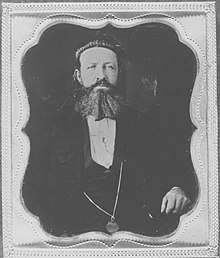Warder Cresson
Warder Cresson (July 13, 1798 – November 6, 1860) was the first U.S. Consul to Jerusalem. He was appointed in 1844.[1]

Life and work
Warder Cresson (later Michoel Boaz Yisroel ben Avraham) was born in Philadelphia, Pennsylvania to a Quaker family.[2] He was descended from Pierre Cresson, one of the settlers of Harlem, NY, whose grandson, Solomon, migrated to Philadelphia in the early 18th century. Warder Cresson's father, John Elliott Cresson (1773–1814), married Mary Warder in 1795.
In 1830 he published a pamphlet entitled Babylon the Great Is Falling! The Morning Star, or Light from on High, in which he deplored the extravagance and evil tendencies of the times, and exhorted all Quakers to lead a better and less wayward life. He went through a period of strong religious upheaval, joining a series of sects that appeared to him to represent true religion.
In 1840, he met Isaac Leeser and he became deeply interested in Judaism. Cresson was also influenced by the writings of Mordecai Manuel Noah, who believed that the Jews would soon return to live in Palestine, their national homeland.[3]
On May 17, 1844, he was commissioned consul at Jerusalem, the first person to hold this office. However, the commission was recalled before he arrived in Jerusalem, unbeknownst to him. He speaks of his departure for Jerusalem as follows:
"In the spring of 1844 I left everything near and dear to me on earth. I left the wife of my youth and six lovely children (dearer to me than my natural life), and an excellent farm with everything comfortable around me. I left all these in the pursuit of the Truth, and for the sake of the Truth alone."
Previous to his departure he had been engaged in agriculture at Gwynedd, Pennsylvania, a suburb of Philadelphia.
He was much affected by the surroundings of Jerusalem, became more inclined toward Judaism, and assumed the name Michoel C. Boaz Israel. In 1844–1848, he was a frequent contributor to Isaac Leeser's magazine, The Occident, in which he criticized the missionary tactics of the London Society for Promoting Christianity Amongst the Jews.
While in Jerusalem he became close to the Sephardic community. He was a friend of Chacham Yehiel Cohen and the next chief rabbi, Elyashar. In 1848, he sought to become a Jew. In March of that year, he was circumcised and converted to Judaism. He returned to Philadelphia in September 1848 to arrange his affairs and move permanently to Jerusalem.
The family tried to keep him from carrying out his plans and claimed he had lost his sanity. He became estranged from all except one son. In May 1849, his wife, Elizabeth Townsend, and his son Jacob applied to the court and had him declared insane.[2] He appealed this decision, and the trial, which went on for six days in May 1851, became one of the famous cases of the time. Eminent counsel were retained on both sides and nearly one hundred witnesses were called. The decision of the lower court was reversed, and Cresson was discharged. The argument of Horatio Hubbell Jr., one of his lawyers, was published in "The Occident" in 1863, with comments by Isaac Leeser.
During his stay in Philadelphia, he was a regular attendant at the Mikve Israel synagogue, taking part in Jewish communal life, and rigorously observing Jewish religious law. He wrote for "The Occident," and in 1851, published The Key of David: David the True Messiah, or the Anointed of the God of Jacob.
Agricultural colony in Palestine
Soon after the trial, Cresson returned to Jerusalem and actively supported efforts then being made for the agricultural regeneration of Palestine. In the fall of 1852, when Sir Moses Montefiore and Judah Touro were working along the same lines, he announced his intention of establishing an agricultural colony in the valley of Rephaïm. In March 1853, he published a column in "The Occident" and sent a circular from Jerusalem soliciting assistance for his projects. Though interspersed with much theology and quotations from the Bible, the circular is one that only a practical farmer and educator could have produced. Cresson believed that the prevailing distress could be relieved by the establishment of agricultural colonies, and that oppressed Jews from all parts of the world should return to Zion.
Cresson married a Sephardic Jewish woman, Rachel Moledano, shortly after his return to Jerusalem in 1852. They had three children, Abigail, Ruth and David Ben-Zion, all of whom died young. He lived the life of a pious Oriental Jew, dressed as a native Sephardi, and became a prominent leader of the community. He was buried on the Mount of Olives. In 2013 Cresson's lost gravesite was rediscovered.[4][2][5]
Published works
- The Two Witnesses, Moses and Elijah, London, 1844
- The Good Olive-Tree, Israel, 1844
- Jerusalem, the Center and Joy of the Whole Earth, Philadelphia, 1844
References
- "Former Principal Officers and Consuls General". Consulate General of the United States - Jerusalem. Archived from the original on 21 September 2015.
- "Warder Cresson". www.jewishvirtuallibrary.org.
- "Warder Cresson: From Shaker to Quaker to Orthodox Jew" (PDF). stevens.edu.
- Hasson, Nir (6 October 2013). "Grave of the 'First American Consul' in Jerusalem Uncovered" – via Haaretz.
- http://www.jewish-american-society-for-historic-preservation.org/images/The_Fight_for_American_Religious_Freedom.pdf
